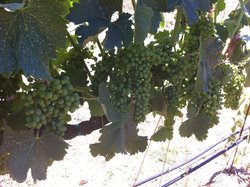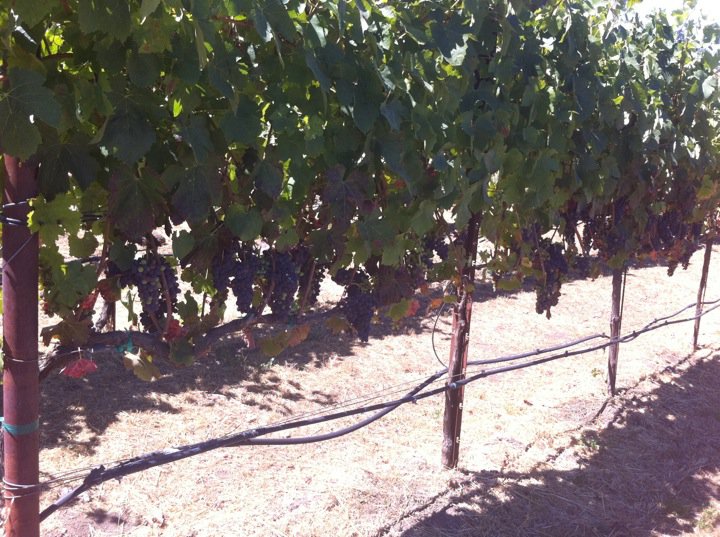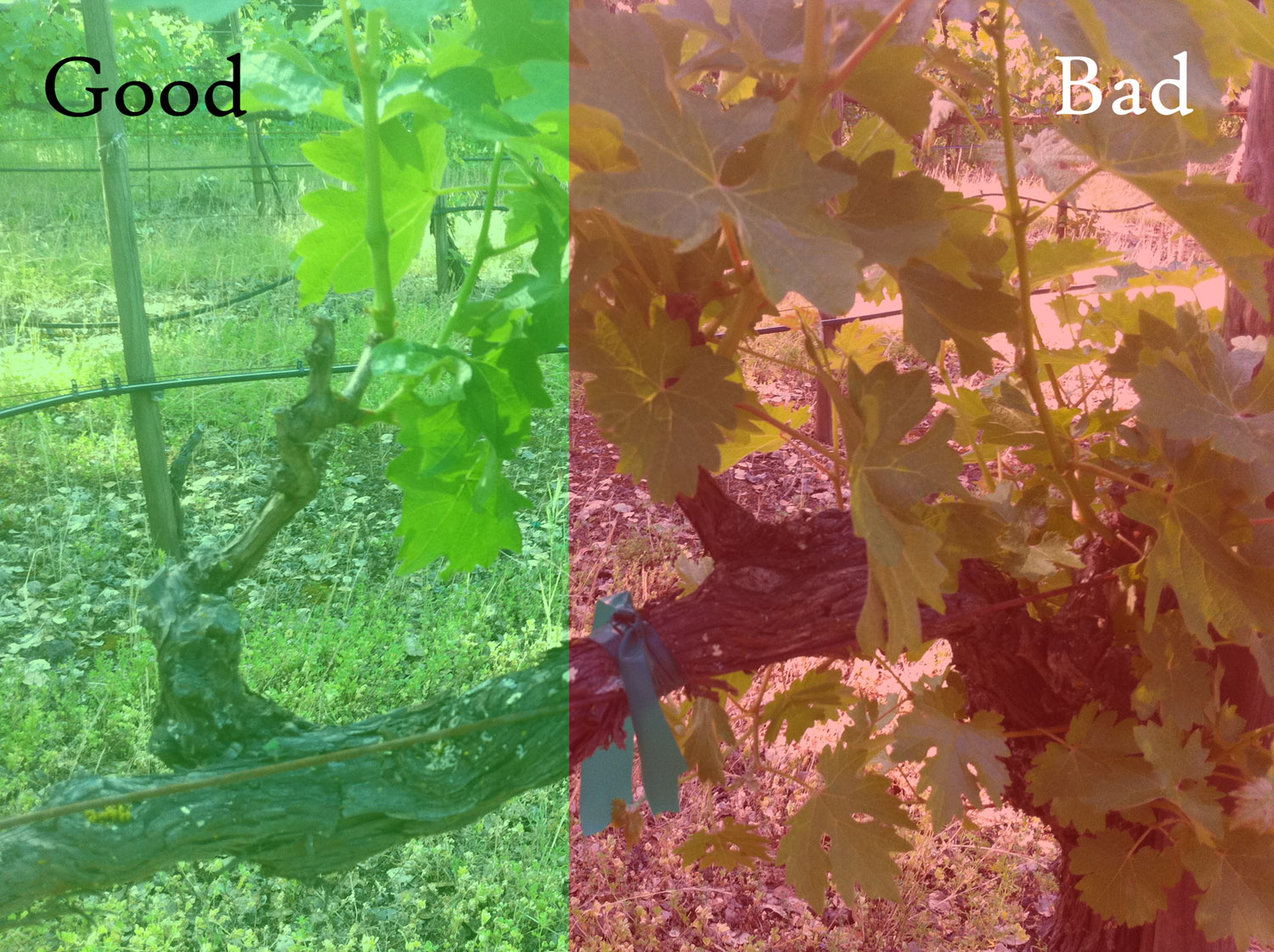Entries in vines (10)
What Happened To Summer?
 Thursday, August 5, 2010 at 2:44PM
Thursday, August 5, 2010 at 2:44PM A couple of days ago the front page of the San Francisco Chronicle informed us Californians that our cool summer was here to stay. Like everyone else I was looking forward to the heat after a particularly wet spring. That sun never really came and now that it's August I suppose that I'll just have to wait until next year for a proper summer. All of the crops seem to be waiting for the sun too. Everyone I talk to has the same story to tell: Their backyard gardens are about a month behind. The grapes are no exception. Growers around the Valley complain that their grapes are lagging about 3 weeks behind. Unripe clusters of grapes on August 1st
Unripe clusters of grapes on August 1st
At this rate, everybody jokes, they won't be ready to harvest until the December 1st. Typically, harvest starts at the end of August or the beginning of September. The concern is that they don't fully ripen before the heavy rains arrive. I've written about what can happen if that is the case in a past post. The harvest of 2009 was a similar story with late ripening grapes. It's during the challenging years that the talented winemakers stand out though, and last year Deerfield produced some spectacular wines. It is very strange that while girls are walking down the streets of Moscow in bikinis and the East Coast is seeing record highs that I find myself wishing I had brought my sweatshirt along. I have never put much faith in long term forecasts and I'm still holding out for the sun. It's only the beginning of August after all - there's plenty of time for beach weather. The seasonal pond in Kenwood Marsh is emptying on schedule so perhaps the grapes will ripen on schedule after all. The truth is that until the fruit is on the sorting table no one really knows what 2010 will be like for Northern California.
The Grapes Ripen (Finally!)
 Wednesday, September 8, 2010 at 10:36AM
Wednesday, September 8, 2010 at 10:36AM Though the grapes have been maturing slowly, the fruit hanging on the vines has almost completely turned red during the process called véraison. In other posts I’ve used the term véraison quite a bit and briefly explained its meaning but didn’t go into much detail. It is a borrowed French word meaning “the onset of ripening” and in English it is defined as the “change in the color of the grape berries”. Up until this point in the life cycle of the vine they have been expending their energy dividing and expanding the cells which form the grapes. The reddening of the grapes mark the moment that growth stops and ripening begins. The green turns to the familiar red hue of the grapes as chlorophyll breaks down and new pigment molecules such as anthocyanins are formed.
The acidity in the grapes begins to decrease as sugar accumulates. You may be familiar with the measurement Brix which is the percentage of sugar in the juice. Each week, the grapes will gain about 1.5ºBrix until they are fully ripened, usually at around 25ºBrix. Depending on the varietal, the winemaker may choose to harvest the fruit well before they become this sweet. Brix may rise further due to dehydration of the berry with no further sugar being produced.
This year I’ve really enjoyed watching the vines transform from little more than twigs into great leafy hedges. I’ve been eating the grapes throughout the growing season even when they were so sour they made my face pucker. It wasn’t until véraison occurred that they started to actually taste like grapes. The vines have a finite amount of energy available to produce the fruit. The trick is to channel that energy into producing high-quality, fully-ripened berries.

You hear the phrase “dropping fruit” a lot this time of year. It means removing clusters of grapes so that each vine has fewer bunches with the aim of producing more flavorful grapes. This is definitely something that distinguishes the wine industry from other agricultural industries: Growers get paid by yield, like every other farmer, but many are dedicated to quality and are willing to reduce yield to increase quality. At this point some of the clusters are lagging behind – while most of the bunches have reached 100% véraison, a few stragglers still have half of their green berries left. These bunches will never fully ripen and in the meantime just sap the energy out of the vine that could be used to ripen the other grapes. These green bunches will be cut off and sacrificed to help ripen the rest.
The crew is busy cleaning the winery in preparation for the incoming fruit but the harvest is so late this year that it’s likely they will finish well before the first grapes arrive. We’ll be using this downtime to send the crew into the vineyard to drop under ripe bunches and remove any grapes that raisined due to sun burn during the heat wave last week. Usually the grapes laid bare to the sun have a chance to tan, thus protecting them from sunburn. This year they never tanned. It was too cold. When the heat wave hit and temperatures got up to 105º these exposed berries got burned. Most of these bunches will be culled along with the green bunches.
Grapes Don't Like Chilly Wet Mornings And Neither Do I
 Thursday, October 28, 2010 at 8:28AM
Thursday, October 28, 2010 at 8:28AM When I moved into my tent at the winery over a year ago I wondered why in the early morning I would hear what sounded like a fleet of helicopters landing in the vineyard. I now know that what I was hearing was the sound of vineyard owners battling the frost that threatened to destroy their grapes. If the temperature drops to below 32º F for more than 30 minutes there is a chance that ice crystals will form within the plants cells and destroy any green growth. During the spring when the buds are forming that will produce the fruit for harvest, the entire crop is vulnerable. In the fall early rains mixed with low temperatures can cause the grapes to shatter on the vine. Growers have developed a number of ways to combat this potentially disastrous scenario. Overhead sprinklers are one such technique. By covering the vines in water constantly the plant tissue will remain at 32º as long as the temperature is above 20º. The technique is effective but the systems are expensive, require maintenance and use about 55 gallons per acre per minute to be completely effective. That’s a lot of water. Heaters have also been used, though usually in conjunction with another method. Vineyard heaters for commercial use must comply with California emission standards but still can burn up to about a gallon of diesel fuel an hour per unit. Imagining the vast vineyards of California blanketed by these heaters makes the environmentalist in me cringe. The fans I mentioned earlier circulate the warmer air that is higher in the atmosphere. These can raise the temperature at the level of the grapes to 1/4th the difference between the temperature at 4 feet off the ground and 40 feet. So if there is a 4º temperature difference the fans will effectively raise the temperature at the height of the vines by 1º. The Department Of Agriculture’s Natural Resource Conservation Service is working with vineyards owners to switch to this method to conserve water. Maintaining soil that radiates heat effectively is an important component that can be utilized to bolster any frost protection strategy. Soil that is clean, firm and moist is best. Research recently done at the University of California, Berkeley indicates that the ice crystals that form in plant tissue must have a nucleus on which to form. Bacteria is what provides such a nucleus so by reducing the amount of ambient bacteria present on the vines the risk of frost should theoretically be reduced, though this strategy has yet to be implemented commercially. Frost damage is not a threat everywhere in California but in the Valley of the Moon where Deerfield Ranch Winery is located it is a threat that we contend with every year. We made it through spring without too much issue, though we did use our dual purpose irrigation system which makes use of water that is recycled by our on-site water treatment bioreactor. Usually, in Sonoma county, fall frosts which damage crops are rare because typically the fruit has been harvested. We can't seem to catch a break this year: A frost warning was issued for Wednesday morning. It looks like this time that the threat didn't materialize though. Deerfield is planning to pick its entire Syrah vineyard by mid next week. I'll let you know how it goes!
What Happened To Winter?
 Wednesday, February 9, 2011 at 10:01AM
Wednesday, February 9, 2011 at 10:01AM While there was snow on the ground in Dallas, Northern Californians were enjoying 80 degree weather this Super Bowl. Everyone has been relishing summer temperatures in the middle of winter and basking in the unexpected sun. As much as I like to be an optimist, this Cellar Rat is a little concerned about what this reprieve from cold weather might mean. The extended forecasts say our little block of summer is due to end next week. I for one am eager for more rain and I’d imagine the vines are too. My concern isn’t that they won’t get enough water – grapevines don’t need very much H2O and, in fact, less water produces better winegrapes. What I’m worried about is that the precipitation is simply being deferred and that we’ll have a particularly wet spring.
In this episode of Cellar Rat TV, I talked last spring about the potential of heavy rains during spring damaging the flowering buds and ruining the fruitset. If that happens then many bunches of grapes will only have some of their berries developed and come harvest, the pollenated “shot berries” will be a major problem to contend with. Too many of them in the fermenting must can cause astringent flavors or undesirable green notes.
The other challenge we face every spring is the threat of frost damage. Frost doesn’t damage the lignified (or wooded) parts of the vine but it can destroy or irreparably damage the cells of green growth. Therefore, I’d rather the vines face the cold weather now before they begin to bud than later in the season.
I’m no meteorologist but I would put my money on winter coming back with a vengeance. My apologies to those Californians who would rather be tanning than splashing in puddles, but I hope that we see some spring showers in the near future.
 vines
vines Gotcha Sucker!
 Wednesday, May 11, 2011 at 3:01PM
Wednesday, May 11, 2011 at 3:01PM It’s spring time in the valley and the vines everywhere have erupted. The heat hasn’t yet begun to brown the grasses so the hills are rolling shades of green. In every vineyard an important job is being done now that the vines have sprouted shoots. There are many different trellising techniques and I’ve talked about a few of them employed in the area in this post, as well as different philosophies of how to best manage vines. All these different systems share the same goal, however, which is to channel as much of the vine’s energy and nutrients as possible to the development of the fruit that we use to make into wine. The winegrower’s job is to coax the vine into only producing structures that directly assist in helping form intensely flavored, delicious grapes – everything else the vine tries to produce should be removed.

Deerfield’s vineyards use the double cordon training system that is commonly employed in California. In this system the vertical vine is split into two horizontally trained arms called “cordons”. Each cordon is then pruned every year so that it has four growth nodes called “spurs”. The vine is trimmed back to this state every year and these parts lignify (become wooden) and grow thicker with each passing year. Every year new shoots called “canes” sprout from the spurs and it is these green shoots that bear the fruit. Each cane is supposed to bear only one or two bunches of grapes.
No matter how your vines are trained they will always sprout some shoots in the wrong places. If left unchecked these shoots will suck up valuable resources and may even try to produce some unproductive grapes of their own. These “suckers” need to be removed as soon as possible, before the vine starts producing the buds that will become the clusters of grapes. Vineyard crews spend much of spring visiting each vine and making sure it’s behaving properly by snapping off extra shoots or sometimes shoots that just aren’t where they’re supposed to be. At the end of the day, for vineyards using the double cordon system, each vine should have just 16 new canes growing. It’s a much easier job then pruning in the winter because the young shoots can just be snapped off easily by hand, as opposed to when they become partially lignified and need to be clipped with powerful shears.
I’ve been paying close attention to one vine in particular this year, watching its growth and documenting it. I take great pleasure in watching it progress a little more each day. The rate of growth is truly fantastic. Yesterday the buds that would become grape clusters were barely perceivable and today they’ve burst into the tiny calyptra that will blossom into the flowers. The shoots grow almost an inch daily! Of course the real excitement begins when the grapes start to ripen…
 trellising,
trellising,  vines,
vines,  viticulture
viticulture 
